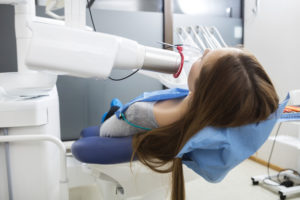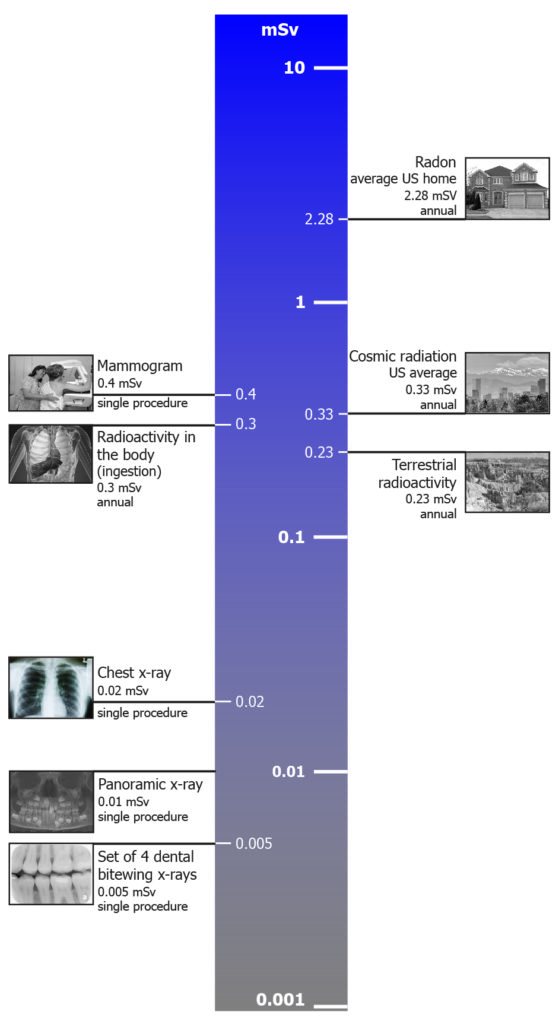Are These Dental X-Rays Safe?
 This is a very important question and one we hear quite often. In recent years, there has been a lot of information and misinformation available about dental x-rays on the internet. We understand that this question arises from a fear of the danger of radiation. After all, radiation is a tool used to fight and kill cancer cells, so doesn’t it harm healthy cells, too. The truth is that it can lead to tissue damage in high doses.
This is a very important question and one we hear quite often. In recent years, there has been a lot of information and misinformation available about dental x-rays on the internet. We understand that this question arises from a fear of the danger of radiation. After all, radiation is a tool used to fight and kill cancer cells, so doesn’t it harm healthy cells, too. The truth is that it can lead to tissue damage in high doses.
Which brings us back to the original question: are these dental x-rays safe?
Changes in Dental X-Rays
In the past, dental x-rays required a significant amount of radiation in order to put an image of teeth onto a small piece of film. The larger the film (like those big panoramic x-rays), the more radiation it took. No dental x-ray ever caused as much radiation exposure as a chest x-ray, but the frequency of dental x-rays as compared to chest x-rays leads to a cumulative dose over time that is comparable.
Advancements in digital technology have made dentistry safer than ever before. Digital x-ray sensors are able to acquire a high resolution image of the teeth and bone with very little radiation. New three-dimensional technology in cone beam computed tomography (CBCT) imaging allows us to gather an almost unbelievable amount of information with less radiation than a traditional panoramic x-ray on film.
The changes in dental x-ray technology allow us to gather more information with less radiation. And the research is ongoing, so you can expect that every new radiographic advancement will lead to a lower dose of radiation.
How Many X-Rays should a Healthy Adult Have?
In general, the average adult dental patient needs to have four small close-up images of the teeth taken about once a year. A large image capturing both the upper and lower jaws should be taken once every five years.
We determine the need for dental x-rays based on a patient’s risk for dental disease. Those with a high risk for decay (cavities) or progressing gum disease may require x-rays on a more frequent basis than someone with little to no risk for these problems. Even those with no risk for cavities or gum disease need dental x-rays on a less frequent but consistent basis in order to confirm their dental health and screen for other disorders in the teeth and bone.
Are Dental X-rays Safe for Children?
Children are at a higher risk for tissue damage from radiation as their tissues are rapidly changing and growing. For this reason, we typically take fewer x-rays on our littlest patients. The total amount of radiation from a “normal” set of dental x-rays for a child is perfectly safe to undergo once a year. In fact, the amount of radiation from dental x-rays for a child is less than they experience from the air and ground around them (which varies depending on where you live).
Are Dental X-rays Safe for Pregnant Women?
Yes.
The American College of Obstetricians and Gynecologists states that dental x-rays are perfectly safe for the mother and fetus when a protective lead apron is used (which we do for every patient, not just our pregnant ones).
We typically refrain from taking any x-rays during the first trimester, which is when the baby’s organs are changing and growing the most. We only take x-rays if necessary during the second and third trimesters. What makes x-rays “necessary”? The risk of a dental problem that could lead to an emergency during pregnancy and affect either the mom or baby’s health. (We like to see our pregnant patients on a more frequent basis for check-ups and cleanings so that we can prevent this risk but that’s the topic for another blog…..)
Risk vs. Benefit
 The more important conversation to have about dental x-rays is the one discussing the risks of radiation versus the benefits. The risks of tissue damage from dental x-rays is extremely low. The risk increases if someone has far more than the standard number of x-rays per year. The benefit of dental x-rays are the ability to intervene and stop dental disease in early stages, preventing dangerous infections and emergencies.
The more important conversation to have about dental x-rays is the one discussing the risks of radiation versus the benefits. The risks of tissue damage from dental x-rays is extremely low. The risk increases if someone has far more than the standard number of x-rays per year. The benefit of dental x-rays are the ability to intervene and stop dental disease in early stages, preventing dangerous infections and emergencies.
Another way to put it would be to compare the risk of dental x-rays versus the risk of not taking dental x-rays. As we’ve already stated, the risk of dental x-rays causing any tissue damage is extremely low in a healthy adult. The risk of not taking dental x-rays is allowing dental disease to progress unchecked. Large cavities or advanced gum disease are chronic infections, which not only can lead to emergencies and pain. They can also affect your overall health.
Dental abscesses from large cavities can spread to the airway, bloodstream or brain and kill you. Chronic gum disease makes it harder for diabetic patients to control blood sugar. It is also linked to heart disease, strokes, and Alzheimer’s disease. It is safe to say that the risks of NOT taking dental x-rays are much higher than the risk of suffering any tissue damage from taking them.
Because taking consistent dental x-rays allows your dentist to diagnose and treat these issues before they reach a chronic state, the benefits far outweigh the risks.
More Questions about Dental X-rays?
Call Designer Smiles today to schedule a consultation with Dr. Ann and Dr. Lauren. They can answer any of your questions about our specific dental x-ray systems and your specific risks of dental disease.
